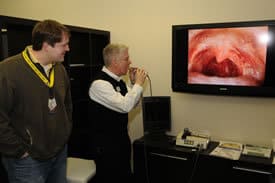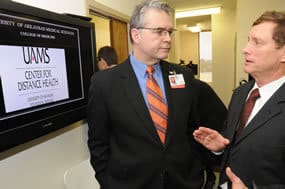UAMS Opens Telemedicine Training Center
|
April 1, 2009| Telemedicine is catching on because not only can doctors and patients see each other via two-way video, doctors also can see what’s ailing them with a variety of telemedicine devices. Now the region’s first telemedicine training center for doctors and hospitals has opened at the University of Arkansas for Medical Sciences (UAMS). UAMS’ Center for Distance Health training center, housed at University Tower, has a full range of monitors and other telemedicine equipment available for training. The Center already has trained physicians, researchers and information technology specialists representing hospitals, clinics and academic medical institutions from such places as New Orleans, Memphis, Panama City, Fla., and Albuquerque, N.M. Countries such as Uganda, Zambia, Nepal, South Africa and the Philippines also have sent hospital and clinic representatives to learn how to use telemedicine. “Telemedicine involves using the latest technology to allow doctors to provide care to patients who may be in another hospital or clinic miles away,” said Curtis Lowery, M.D., co-director of UAMS’ Center for Distance Health and chairman of the Department of Obstetrics and Gynecology. As Arkansas’ only academic medical center, UAMS is home to many highly specialized physicians. Making their expertise more widely available through telemedicine has been a goal for UAMS. Specialists can consult with their patients’ primary care doctors in another city and view the patient’s X-rays, CT scans and live ultrasounds. As a maternal-fetal medicine specialist, Lowery in 2003 put UAMS’ telemedicine program on the national radar. The innovative program, which involves partnerships with the Arkansas Department of Human Services and the Arkansas Medical Society, won national recognition and was the springboard for UAMS to become a model for telemedicine. “This is evolving very rapidly, and doctors as well as patients need to know how to use this technology,” Lowery said. “I would envision in the not-to-distance future that many of these systems will be in many people’s homes. So you won’t go to the doctor, your doctor will virtually come see you in your house.” “This is the way things are going to go; there’s no stopping it,” he added. “It’s beneficial to the doctors and patients and improves health care.” |

